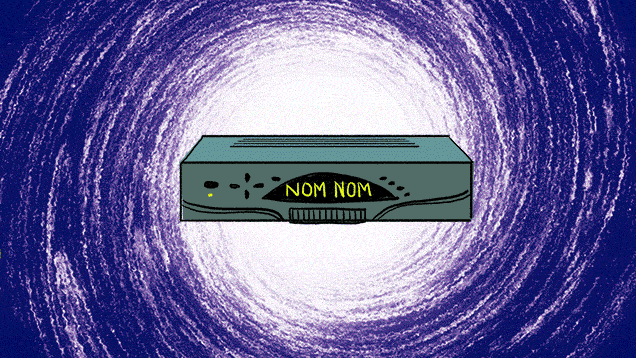An innocent little cable box can suck up more electricity than your actual TV. The most galling part though? Up to two-thirds of its power-hogging actually happens in “idle” mode, when you’re not even using it. The good news is device makers have the technical ability to make cable boxes that don’t waste so much electricity. They just need to actually do it.
Things are starting to look up — albeit slowly. Back in 2011, the Natural Resources Defence Council (NRDC) put out a scathing report on set-top boxes, the technical name for devices that converts signals broadcasted by your cable company into video and sound. At the time of the report there were about 160 million of them in the US, and they collectively slurp up 27 billion kilowatt-hours of electricity.
To put it in more wallet-hitting terms, Americans pay $US3 billion a year to power set-top boxes, $US2 billion of which is wasted on boxes whirring away when the TV is off. Yikes.
Since the report, the cable industry has, with the NRDC’s input, hammered out a Voluntary Agreement [PDF] to reel in the energy waste. The agreement sets deadlines for cables boxes to meet modest energy savings (“Tier 1”) by 2014 and additional savings (“Tier 2”) by 2017. From 2012 to 2013, the energy consumption of new set-top boxes bought by cable companies to give to customers actually did drop 14 per cent.
But, frankly, that’s not enough, especially when you consider we’re starting at a baseline where the majority of the wasteful energy consumption happens in idle mode when the gadgets aren’t even in use.
“They’re making incremental, slow progress,” says Noah Horowitz, an NRDC senior scientist who has been working on this with cable companies. “The technology to reduce energy is there, and we need the industry to step up.”
Making cable boxes more energy efficient
The key to conserving electricity is creating different levels of sleep — something in between on and off. To give a rough analogy, your phone doesn’t use nearly as much energy when it’s waiting for a call than when it’s downloading a song. You set-top box doesn’t have to either. Here are the energy-saving features that have, or should, become standard.
Automatic Power Down
You’re done watching Real Housewives (hey, no judgment), and you turn off the TV but you forget about your cable box. This is exactly why Automatic Power Down (APD) was created, to transition the box into a sleep mode when you’ve stopped watching. APD has been incorporated in almost all new set-top boxes since January 2013 under the Voluntary Agreement.
APD is a great, but it only makes sense if there is a sleep mode to power down to. Manufacturers are still just beginning to implement sleep modes that 1) actually reduce energy usage substantially and 2) don’t take several minutes to wake up from.
Light Sleep
If you’ve ever unplugged your idle cable box, you’ve probably had to wait several frustrating minutes for it to reboot. One strategy is to create a lighter sleep mode called, what do you know, light sleep.
Certain components, such as the spinning hard drive of the box’s digital video recorder (DVR), stop drawing power when not in use. The device itself, though, is still able to listen for instructions coming from the network, and it would take less than a minute to fully resume. The light sleep mode in current boxes shaves off about 5 watts from the 25 watts of the typical active box.
Deep Sleep, or the “Holy Grail”
Light sleep is a start, but it doesn’t account for huge energy savings. To really get there, we need deep sleep, an even lower-energy version. It could be possible to pre-program deep sleep for the dark hours of the night, but to be truly useful, boxes should to be able to go into deep sleep and wake up quickly. “That’s the holy grail,” says Horowitz.
But there’s a reason manufacturers haven’t rolled this out yet. Deep sleep with quick resume requires redesigning not only the physical box, but how the box communicates with the cable company’s servers.
Cable boxes and servers exchange periodic handshakes as a way of making sure you’re not stealing the cable signal. New software would have to be rolled out to account for boxes in deep sleep. At the same time, because set-top boxes usually last for six years, the network still needs to be backwards compatible with old boxes designed to communicate according to old protocols.
These systemic changes are way harder than tinkering with just the set-top box itself. But it’s possible.
The best choice (for now): Energy Star 4.1
Energy-hogging set-top boxes have persisted so long, in part, because of a fundamental disconnect in the market: the people who chose the boxes (cable companies) aren’t the people who have to foot the electric bill (you).
But you can choose your cable company. “Request, ‘Hey, if you want me to be your customer, I need an Energy Star 4.1 box. If not, I’ll go elsewhere,” says Horowitz. Boxes that adhere to the Energy Star Version 4.1 specifications will get you the most energy-efficient boxes currently available. Be advised, though, there are also boxes certified under Energy Star Version 3.0, so be sure to request 4.1.
You’re the one paying the bills after all — your cable bill and your electric bill.
Illustration: Tara Jacoby
